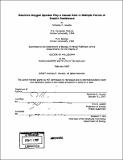Reactive oxygen species play a causal role in multiple forms of insulin resistance
Author(s)
Houstis, Nicholas E
DownloadFull printable version (8.616Mb)
Alternative title
ROS play a casual role in multiple forms of insulin resistance
Other Contributors
Massachusetts Institute of Technology. Dept. of Biology.
Advisor
Eric S. Lander.
Terms of use
Metadata
Show full item recordAbstract
Insulin resistance is a cardinal feature of type 2 diabetes and is characteristic of a wide range of other clinical and experimental settings. Little is known about why insulin resistance occurs in so many contexts. Do the various insults that trigger insulin resistance act through a common mechanism? Or, as has been suggested, do they utilize distinct cellular pathways? Here, we report a genomic analysis of two cellular models of insulin resistance, induced by treatment with tumor necrosis factor-a and dexamethasone. Gene expression analysis suggested that reactive oxygen species (ROS) levels were elevated in both models, and this was confirmed through measures of cellular redox state. ROS have been previously proposed to be involved in insulin resistance, although evidence for a causal role has been scant. To test this hypothesis, six treatments designed to alter ROS levels, including two small molecules and four transgenes, were tested in cell culture; all ameliorated insulin resistance to varying degrees. One treatment was tested in obese, insulin resistant mice and was shown to improve insulin sensitivity and glucose homeostasis. Our results suggest that elevated ROS levels are an important trigger for insulin resistance in multiple settings.
Description
Thesis (Ph. D.)--Massachusetts Institute of Technology, Dept. of Biology, 2007. Includes bibliographical references.
Date issued
2007Department
Massachusetts Institute of Technology. Department of BiologyPublisher
Massachusetts Institute of Technology
Keywords
Biology.